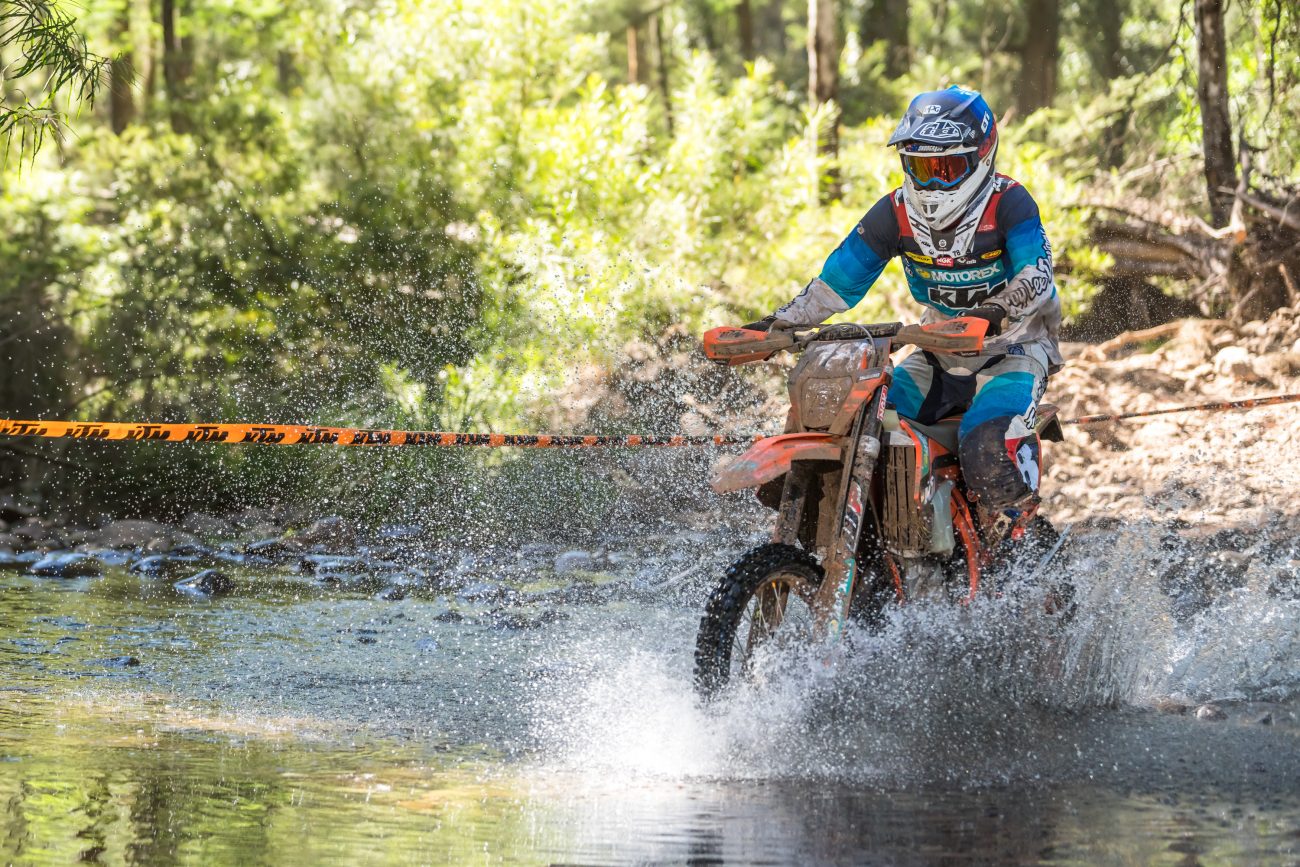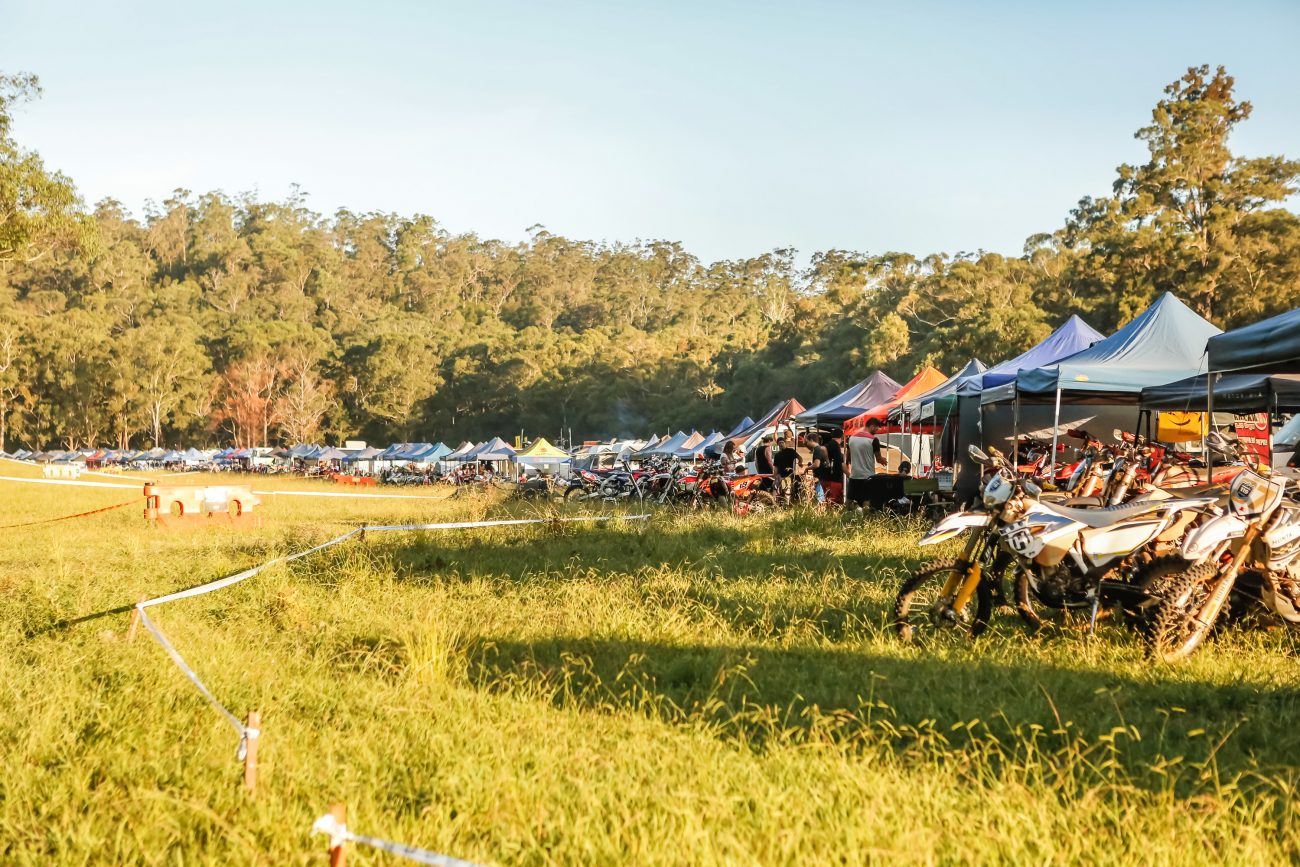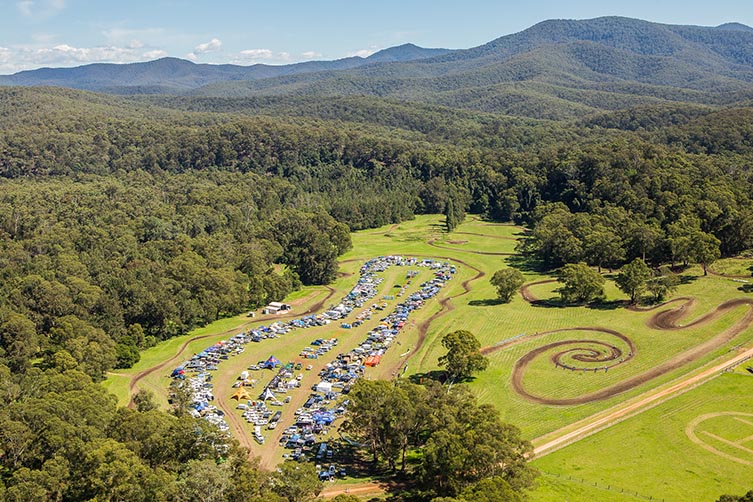Although this was originally posted in the 2013 Issue 33 of Transmoto Magazine, we think this will help you make your 12-Hour experience even better. So sit down, grab a beer and get learning…
For all the road trip and mechanical stories, let’s not forget why we went to the 12-Hour in the first place – to ride. And who better to tell us how we should have ridden than course designer, Lyndon Heffernan.
From deep within the surrounds of the campsite pit area on Saturday before race day, there was lots of excitable talk as to where the course would take the riders. And more importantly, how hard would it be. By catering for such a cross-section of the off-road population, the challenge was to make the lap demanding, rather than demoralising. And judging by the dusty smiles we saw come the Sunday’s chequered flag, we reckon Lyndon “Heffo” Heffernan – legendary trainer, rider, and the man in charge of plotting the 15km loop – can now add damn fine course builder to his CV. Using the natural lay of the terrain to great effect, he and his team of tireless volunteers made sure that everyone – from the Pros to the first-timers – were challenged, but had great fun, along the route. But what were the harder sections of the Transmoto 12-Hour? And what was the best way to attack them? We ventured bush to watch and record the styles of a cross-section of the 12-Hour community, and then asked Heffo to talk us through the best approach to each. We’ll tackle the obstacles in the order in which the rider’s approached them on their loops. Hopefully the memories of the day will come flooding back as we guide you round. Enjoy!

Within a kilometre of the start area, it would have been clear to all that this was no firetrail free-for-all. From the open paddock of the start, the riders quickly dived into the forest’s canopy, having to adjust to the reduced visibility and changing terrain. It got tight pretty quickly, and the ground was already dry and soft. It didn’t take too long for ruts to appear as the Pros led the charge through the trees. As the mixed ability field throttled through, those ruts became wider and less defined.

It was essential to keep that startline enthusiasm in check, as running wide and having the front sucked into the softer ground saw many falter and lose momentum. An unlucky few even went further than that and literally got their first actual taste of the 12-Hour. Mmmmm, fluffy… Due to the fluffy the nature of the terrain, it was essential to weight the bike properly in the tighter corners. The Pros were mostly standing here, but the rest of us felt better sitting. If you had your weight up over the bars, it was game-on for a decent corner style and momentum-keeping result.

Heffo’s View
“This section is a real ‘wolf in sheep’s clothing’. The grass covers the sandy loam that doesn’t stay flat for long, and the tight turns get really rutted and then they get very bumpy. Early on, MX-style sitting down is the go with weight well forward to keep the bike in the ruts. But once the ruts get bumpy, it is time to adopt a half sit, half stand technique, that allows the bike to work better over the bumps. The downside to this posture is that it really burns up the energy. Alternately, some riders will stand up, Stefan Merriman-style, all the way through really rutted turns.
This requires the balance of a gymnast and the throttle control of a trials champion, and these are not normal attributes of the average trailrider. So, if your skills and fitness are not like those of GK, Stefan or Toby Price, sitting down and looking for a smooth line is probably the best option.”

After the tightness of the first wooded section, it was a relief to cross the road and click through the gears. Diving back into a tree-lined section led to the first water crossing, before the first real test of a rider’s climbing ability. It would have been a much more straightforward affair, were it not for the approach. A couple of tight corners before the climb started saw many lose speed even before the ground started to head skyward. And there was more to come. The natural berm that appeared at the approach to the climb itself had a vicious kick to it on the exit. This meant that if you just tried to ride the rut to its natural conclusion you would be flicked back across the face of the climb. Many were.

Add in the emerging tree roots that, as usual, were just the wrong angle to the track. It was here that we saw a wide variety of styles and skills firsthand. The Pros could process the terrain quickly enough to be weighting the bike to blast up the hill without being thrown to the right. Their attacking approach meant for more speed up the hill with much less wheelspin. Other people’s dramas often started even before the rut ended. A lack of velocity at the base meant for wheelspin from the get-go – allowing the bike to be affected by every root and rock on the incline, rather than floating over them.

Heffo’s View
“Hills are all about momentum and, when you have a hill straight out of a tricky turn, it is imperative not to get ahead of yourself and worry about the climb. You have to nail the turn first! The last-minute blast of throttle when people see the incline is what brings most of them undone. Top riders can easily look, analyse and then pick the right line up most ascents with ease. I think the most important thing is to look ahead. That includes looking around the corners as much as possible so you have more time to plan the approach. Then pick a line up the climb and keep your weight forward. Smooth throttle and the right gear will see the bike drive over the bumps and push you forward and upward.

The lap’s first water crossing was more of a bike clean than a challenge. There was no real drop into the section and the exit was clear to see. Also, after a few laps, riders knew it was pretty flat on the bottom and managed to literally flow through it. There wasn’t a mountain of time to make or lose here. The second crossing was more of an ordeal for some. There was a pretty high-speed, downhill approach to the water, which ended in a 90-degree left, before the land gave way to the flow. The more experienced riders would already be looking left to plot their attack before they got to that last corner, allowing momentum to be kept up and the risk of front wheel grabs and flooded engines to be minimised.

With speed came a mini bow-wave, that actually kept the rider drier and faster. Others took their time and practically stopped after the left-hander. This meant that they entered the water at little more than walking pace and were up against it from the start. With the rocky base of the river hungry for front wheels, this would see feet down and rear spinning action as the rider struggled against the terrain and the pressure of water. Some managed to stall mid-way, and the sound of sphincters clapping shut could be heard as panicking riders stabbed boots against slippery rocks to prevent a fall.

Heffo’s View
“Speed and line choice is imperative in creek crossings, and avoiding the bigger rocks is always a big help, too. I usually stand so the bike’s suspension can cope with things better, but if I am not sure what is in the bottom, I will sit so I can dab my foot if needed – better wet boots than a wet engine!
The speed required is just above walking pace so your wheels will roll over the rocks and not bog into any soft areas. Too much speed creates a wet rider and can produce deflection off larger rocks. On most bikes, it is important to keep the revs up because if the carb vent hoses go underwater you will stall. Slipping the clutch ensures you don’t produce speed when keeping the revs high.”

Possibly the trickiest section of the entire lap was the wooded section 11km in. Even at midday, it had the natural light of a cruise ship’s economy cabin and was the place where the guys with the unlit MX bikes were at a real disadvantage. With the riders sweating and goggles covered in dusty streaks (it was here that the soaking you got on the water crossing, and subsequent caked-on goggle dust, started to pay you back), it wasn’t the time to be thinking you’re nearly at the end of the lap and switch off. The ground in here – out of the drying nature of the sun’s glare – remained moist and tacky all day.

This gave great traction but the visibility meant that speeds were controlled, like you naturally do when walking around an unlit house at night. The biggest obstacle was the fallen log in this picture. No real drama in itself, but shortly after was a sharp right. To make this simple option harder, there was a bike’s width gap at the end of the log’s trunk. You could hear rider’s thoughts as they came past: “Do I go over the top or ride through the gap?” Over the top was quickest, but bad planning led to a nasty kick up the arse as the rear wheel bucked off the log. The gap approach saw riders slow to a snail’s pace as it was only just wide enough for the footpegs to rip through. Riding slowly over the top seemed to be the favoured approach by some of the rider’s who, by now, were pushing their fitness (or lack of it) to the limit.

Heffo’s View
“Transitioning from light to low light is difficult as it takes a few seconds for your eyes to adjust. One trick is to close your eyes for a split-second to open the retina quicker. As this rainforest section was very technical, it may have been worth stopping for a few seconds as you enter the darkness and closing your eyes to adjust more quickly and then proceeding through the section. Trade secret: there are two types of goggles lenses that help here, yellow or blue. The yellow will work better in the poor light, but at the 12-Hour, riders were going from full sun to dark shadow, so the blue lens would have been the better choice as it also has a glare reducing ability. In terms of the log that was in the rainforest, the easiest and safest line was to use the cut-out section of the log. However, it took a bit of effort to get to that line. Riders that were too late in picking the log ended up off the cut-through line and had to ride the log at full height. Looking well ahead is a key factor in picking the best lines. Even on the low line, some skill is required to get over logs safely. Logs require a controlled slow wheelie in the standing position to get the front wheel over. I also tend to lean back a bit for traction and to lighten the front wheel. Then I pull the clutch in and lean forward as the rear hits and it will roll over smoothly.

With the pits in sight and only a flat paddock between the riders and a rest (or another lap), this became the area where the taller gears could get a workout. It was a very flowing line that scarred the landscape, and the mown grass soon gave up the good fight and allowed the tyres to taste the dusty soil below. By late in the afternoon, the track had become a dustbowl, the corners banked up with shin-deep ruts. Longer and more open than the slower speed corners at the start of the lap, correct rider weighting was essential to keep up momentum.

The Pros chose a measured approach to the corners that was all about keeping apex momentum and maximum drive on the exit. The dust wave thrown up by their rear tyres was noticeably less than the by-then knackered riders who entered the corner too quickly, braked too late and got bogged at the apex, only to wind the throttle on fully on the exit. This lack of momentum meant that the engine’s power only extracted the soil below the rear tyre and did little in the way of propelling the bike forward. When it did eventually hook up, going forward in a straight line seemed to be the last thing on the bike’s mind, as the high velocity rear tried to overtake the slower front of the bike for at least the next two gear changes.

Heffo’s view
“Natural loose berms are a bit of a lucky dip. If you smash into them with too much angle, you can bury either wheel easily. So, two things I do on these types of turns are: aiming to follow the base of the berm (rather than riding deep in floury sides), and I also tend to use a flat corner body position rather than lean in too much.
This method won’t throw as much roost and won’t look as spectacular, but produces more speed and fewer issues for your air filter. In endurance events, this is a huge consideration, because if you smash 10 of these powder berms per lap, your airbox will be full of powder and this dries the filter’s oil out and creates dry spots … and havoc with your engine.”

How-To Scrutineer
Form an orderly queue, please!” With nearly 500 bikes to get through, the small army of checkers went about their job in a methodical manner. Throttles got twisted (to check for return action), levers got inspected (for end-balls), calipers got eyeballed (for pad meat) and wheels got shook (for bearing play). Very few riders needed a quiet word and nobody got denied the right to ride. Guess that makes this advice pretty redundant, then!

How-To Sign-On
With two previous 12-Hours under our belts, Team Transmoto brought a smarter sign-on to this year’s event. The numbers of riders were still huge, but the direction given out made the short wait bearable. Hell, we even handed out Fantails along the line. In the end, everyone got his or her numbers and transponders within the allotted timeframe, meaning the Race HQ could sleep easy on Saturday night. Riders having their paperwork sorted made life easier. Cheers!

How-To Be Waste Wise
If you looked close enough, you would have seen that the competitor’s packs were bin liners. Brilliant idea, eh? But what was even smarter was that all the people enjoying the event used these “packs” to take their rubbish home with them. As a result, the paddock was nigh-on immaculate come the Monday morning hand-back. Now, we’ve just got to find some volunteers who want to do the same with the portaloos. Anyone keen? Anyone…

How-To Collapse After the Event
It sounds easier than it is; a 12-hour event based on a 15km loop. After the finishing enthusiasm and the effects of the post-race beer or two had subsided, all that was left was the drive home. For some, it’d be mere hours before slumping on the couch. For others, there was another night out before the familiarity of their own beds. And then there was the muscle pain. Feeling alright the day after turned into stiffness and aches after that. But it was honest pain and hard-earnt. And we reckon you’re keen to sign up for next year already…
WHO’S TALKING TO ME?

Lyndon Heffernan had a long racing career, with numerous victories and is a two-time Thumper Nats champion (Pro Open). When he retired from racing, he made the switch to training the next wave of riders. He’s been a coach now for 25 years and has also run four A4DE events as well as AORC rounds. In short, he’s good!
